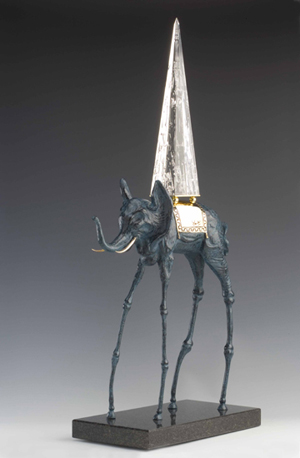Sculptures
 To sculpt is to shape a form into your vision. It is to mold something from what it is into something new. We not only sculpt clay, marble, metals, and woods, but we also sculpt our mind, our city, our dreams, and our imagination. Many artist are drawn to working with their art in the third dimension, it brings the work “closer to real life.” Salvador Dalí was not resistant to the allurement of working in the third dimension. In his lifetime Dalí was able to produce an impressive collection of sculptures. Some of these works were extremely small, and others, stood as examples of some of his largest works.
To sculpt is to shape a form into your vision. It is to mold something from what it is into something new. We not only sculpt clay, marble, metals, and woods, but we also sculpt our mind, our city, our dreams, and our imagination. Many artist are drawn to working with their art in the third dimension, it brings the work “closer to real life.” Salvador Dalí was not resistant to the allurement of working in the third dimension. In his lifetime Dalí was able to produce an impressive collection of sculptures. Some of these works were extremely small, and others, stood as examples of some of his largest works.
Like his paintings and drawings, these sculptures have found their home in many of the world’s finest museums and private collection. Unlike his paintings and drawings, some of his largest sculptures stand in the middle of wonderful city squares, along the banks of historic rivers, and as a decoration to beautiful parks. They become part of the landscape and part of the earth on which they stand. They become part of a city’s and community’s identity. They represent a half way point of reality, between the images and characters in Dalí’s paintings the forms of real life. Dalí’s sculptures were a way to explore the unseen part of his paintings and works. The sculptures are models for what a surreal world would look like if it existed in our reality.
It is being discovered that sculpting might have been the first form of art. Our ancestors roughly molded forms of themselves unto malleable rock and clay. It is in our nature to transform our landscape. It is in our nature to impose our self and our ideas onto the things we encounter in this world. As an artist, one looks for opportunities to do this in order to telegraph our ideas. Dalí’s was easily able to transition his ideas from his paintings to his sculptures. One can look at his paintings and could project how they might appear like in real life. Because of this, Dalí drew heavily from his masterpieces like, The Persistence of Memory, St. George and The Dragon, and Drawers of Memory to create third dimensional versions of them. He took his famous icons like, the melting clocks, Alice in Wonderland, Venus, and snails, and built larger, small, and fascinating examples from the. His sculptures were a legitimate extension of his vision. To this day, his sculptures are highly sought after by art collectors worldwide.
Perhaps Dalí’s most famous sculpture is Lobster Telephone. It was created in 1936 and called a “surrealist object” by Dalí. There are currently five examples of this work. It is often thought of as the quintessential surrealist sculpture. Other similar works Dalí produced during that time was a sofa entitled, Mae West Lips Sofa, where Dalí replicates the lips of the famed actress Mae West. He also created a work called Rainy Taxi, a taxi car fitted with two mannequins and a indoor rainy mechanism. Though traditionally these works were not “sculptures” but rather, as Dalí called them “surrealist objects” they served the same purpose as sculptures did for Dalí, that is to bring his surreal imagery into the third dimension, into real life. Two other examples of a famous work from this era is Retrospective Bust of a Woman and Portrait of Joella. Also in this spirit Dalí created a huge collection of jewelry, much of which is now on display at the Dalí Theatre and Museum. These pieces of jewelry represent other sculpted works by Salvador Dalí. Some of his most famous works from this collection are The Royal Heart, The Eye of Time (a brooch),and Ruby Lips.
Dalí also had his hand in designing furniture. The three dimensional chairs, tables, and stands, where extremely popular among designers. As we already mentioned, Mae West Lips Sofa is his most famous example of his furniture design. Dalí once remarked “A chair can even be used for sitting on, but with just one condition: that we be uncomfortably seated.” Other furniture works by Dalí include Vis-à-vis Gala Armchair, Leda Chair, and a Leda Table, the last two Dalí designed for Jean-Michel Frank and were inspired by his painting Femme A La Tete Rose.
Lately there has been a great interest in Dalí’s metal sculptures. Part of this is due to the fact that many cities around the world have dedicated plazas, squares, parks, and other public spaces to Salvador Dalí. In these spaces there are large sculptures by Dalí, in Madrid there is Plaza Dalí which features a bronze statue of Isaac Newton. There is a Dalí sculpture, Lady Godiva with Butterflies, at The Chateau de Pommard in Bourgogne, France. Along the beach front in Marbella, Spain there are several Dalí sculptures including; Nude Ascending a Staircase, Cosmic Elephant, Perseus, Gala Gradiva, and Gala At The Widow. The bronze sculpture Venus, is located in Courchevel in the French Alps. There is also the Stillness of Time, which is situated right underneath the London Eye along the Thames. There is a wonderful Alice in Wonderland sculpture in Wheelock Place, in Singapore. Also in Singapore are other outdoor sculptures; the famous St. George and The Dragon, Homage to Newton, Surrealist Piano, Horse Saddled with Time, and Unicorn along the Singapore River. Also in France is a huge display of The Vision of The Angel in the Dalí Museum. In China you can go to Exchange Square, Hong Kong and find Woman Aflame. As you see, the sphere of Dalí’s influence is well recorded worldwide.
Many of the sculptures we mentioned were also produced in limited editions. Most of these were not the 10ft. version of the statues located in major international cities. Some his most famous limited edition bronze statues have been, Adam and Eve, which is a wonderful example of Dalí’s ability to shape the human form. Snail and The Angel is a favorite amongst collectors, it captures a brilliant scene, one of hope and triumph. Another bronze masterpiece by Dalí is Rhinoceros Wearing Laces. In Profile of Time, Dalí takes a sample from his work The Persistence of Memory. This sculpture is just the tree limb and a single melting clock, representing an intimate moment when reflecting on the nature of time.
These works stand as a stunning and breathtaking collection. The sculptures Dalí molded are perfect compliments to his paintings and graphic works. In the same way as his other artistic outputs, his sculptures exemplify his surrealism, his dreams, and his philosophy on life and art.


